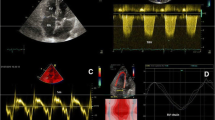Abstract
Background
Idiopathic hypereosinophilic syndrome is characterized by a persistent eosinophil blood count of >1.5 × 109 cells/l and organ damage, independent of the primary and secondary causes of eosinophilia. The purpose of the present study was to assess the three-dimensional speckle tracking echocardiography-derived right atrial volumetric and functional properties between hypereosinophilic syndrome patients and matched controls.
Methods
A total of 11 patients with idiopathic hypereosinophilic syndrome and 22 age- and gender-matched healthy controls were enrolled in the study. Three-dimensional speckle tracking echocardiography was used for calculation of right atrial volumes, volume-based functional properties, and strain parameters.
Results
Significantly increased right atrial maximum (68.7 ± 33.1 ml vs. 40.3 ± 12.1 ml, respectively; p = 0.001) and minimum volumes (48.3 ± 31.0 ml vs. 28.3 ± 9.4 ml, respectively; p = 0.009), as well as right atrial volume before atrial contraction (58.6 ± 27.3 ml vs. 34.5 ± 11.8 ml, respectively; p = 0.001), were found in hypereosinophilic syndrome patients compared with controls. Total and passive right atrial stroke volumes proved to be significantly increased in hypereosinophilic syndrome patients. However, global and mean segmental strain parameters did not differ significantly between the groups.
Conclusion
Increased cyclic right atrial volumes and mild alterations in right atrial functional properties could be demonstrated in idiopathic hypereosinophilic syndrome patients.
Zusammenfassung
Hintergrund
Das idiopathische hypereosinophile Syndrom ist gekennzeichnet durch eine persistierende Eosinophilenzahl im Blut >1,5 × 109 Zellen/l und Organschäden, unabhängig von den primären und sekundären Ursachen der Eosinophilie. Ziel der vorliegenden Studie war es, die in der 3‑D-Speckle-Tracking-Echokardiographie ermittelten volumetrischen und funktionellen Eigenschaften des rechten Vorhofs zwischen Patienten mit hypereosinophilem Syndrom und entsprechenden Kontrollen zu vergleichen.
Methoden
Insgesamt wurden 11 Patienten mit idiopathischem hypereosinophilem Syndrom und 22 in Alter und Geschlecht entsprechend ausgewählte gesunde Kontrollen in die Studie aufgenommen. Die 3‑D-Speckle-Tracking-Echokardiographie wurde für die Ermittlung rechtsatrialer Volumina, volumenbasierter funktioneller Eigenschaften und von Dehnungsparametern eingesetzt.
Ergebnisse
Eine signifikante Erhöhung der rechtsatrialen Maximal- (68,7 ± 33,1 ml vs. 40,3 ± 12,1 ml; p = 0,001) und Minimalvolumina (48,3 ± 31,0 ml vs. 28,3 ± 9,4 ml; p = 0,009) sowie der rechtsatrialen Volumina vor der Vorhofkontraktion (58,6 ± 27,3 ml vs. 34,5 ± 11,8 ml; p = 0,001) wurde bei Patienten mit hypereosinophilem Syndrom im Vergleich zu Kontrollen festgestellt. Die Gesamt- und die passiven rechtsatrialen Schlagvolumina erwiesen sich bei Patienten mit hypereosinophilem Syndrom als signifikant erhöht. Die globalen und durchschnittlichen segmentalen Deformationsparameter unterschieden sich nicht signifikant zwischen den Gruppen.
Schlussfolgerung
Erhöhte zyklische rechtsatriale Volumina und leichte Veränderungen der rechtsatrialen funktionellen Eigenschaften waren bei Patienten mit idiopathischem hypereosinophilem Syndrom nachweisbar.

Similar content being viewed by others
References
Gotlib J (2014) World Health Organization-defined eosinophilic disorders: 2014 update on diagnosis, risk stratification, and management. Am J Hematol 89:325–337
Weller PF, Bubley GJ (1994) The idiopathic hypereosinophilic syndrome. Blood 83:2759–2579
Curtis C, Ogbogu P (2016) Hypereosinophilic syndrome. Clin Rev Allergy Immunol 50:240–251
Chusid MJ, Dale DC, West BC, Wolff SM (1975) The hypereosinophilic syndrome: analysis of fourteen cases with review of the literature. Medicine (Baltimore) 54:1–27
Mankad R, Bonnichsen C, Mankad S (2016) Hypereosinophilic syndrome: cardiac diagnosis and management. Heart 102:100–106
Kleinfeldt T, Nienaber CA, Kische S, Akin I, Turan RG, Körber T, Schneider H, Ince H (2010) Cardiac manifestation of the hypereosinophilic syndrome: new insights. Clin Res Cardiol 99:419–427
Yamamoto T, Tanaka H, Kurimoto C, Imanishi T, Hayashi N, Saegusa J, Morinobu A, Hirata KI, Kawano S (2016) Very early stage left ventricular endocardial dysfunction of patients with hypereosinophilic syndrome. Int J Cardiovasc Imaging 32:1357–1361
Nemes A, Marton I, Domsik P, Kalapos A, Pósfai É, Modok S, Borbényi Z, Forster T (2016) Characterization of left atrial dysfunction in hypereosinophilic syndrome – Insights from the Motion analysis of the heart and great vessels by three-dimensional speckle tracking echocardiography in pathological cases (MAGYAR-Path) Study. Rev Port Cardiol 35:277–283
Nemes A, Kalapos A, Domsik P, Forster T (2012) Three-dimensional speckle-tracking echocardiography – a further step in non-invasive three-dimensional cardiac imaging. Orv Hetil 153:1570–1577
Nemes A, Domsik P, Kalapos A, Gavallér H, Oszlánczi M, Forster T (2016) Right atrial deformation analysis in isolated left ventricular noncompaction – insights from the three-dimensional speckle tracking echocardiographic MAGYAR-Path Study. Rev Port Cardiol 35:515–521
Lang RM, Badano LP, Mor-Avi V, Afilalo J, Armstrong A, Ernande L, Flachskampf FA, Foster E, Goldstein SA, Kuznetsova T, Lancellotti P, Muraru D, Picard MH, Rietzschel ER, Rudski L, Spencer KT, Tsang W, Voigt JU (2015) Recommendations for cardiac chamber quantification by echocardiography in adults: an update from the American Society of Echocardiography and the European Association of Cardiovascular Imaging. J Am Soc Echocardiogr 28:1–39.e14
Kim NK, Kim CY, Kim JH, Jang SY, Bae MH, Lee JH, Yang DH, Park HS, Cho Y, Chae SC (2015) A hypereosinophilic syndrome with cardiac involvement from thrombotic stage to fibrotic stage. J Cardiovasc Ultrasound 23:100–102
Shah R, Ananthasubramaniam K (2006) Evaluation of cardiac involvement in hypereosinophilic syndrome: complementary roles of transthoracic, transesophageal, and contrast echocardiography. Echocardiography 23:689–691
Acknowledgements
We acknowledge Ms. Zsuzsanna Horváth for the data management in this study.
Author information
Authors and Affiliations
Corresponding author
Ethics declarations
Conflict of interest
A. Nemes, I. Marton, P. Domsik, A. Kalapos, É. Pósfai, S. Modok, Á. Kormányos, N. Ambrus, Z. Borbényi, and T. Forster declare that they have no competing interests.
The study protocol conformed to the ethical guidelines of the 1975 Declaration of Helsinki (and updated versions) and was approved in advance by the local institutional ethics committee. Informed consent was obtained from each subject.
Rights and permissions
About this article
Cite this article
Nemes, A., Marton, I., Domsik, P. et al. The right atrium in idiopathic hypereosinophilic syndrome. Herz 44, 405–411 (2019). https://doi.org/10.1007/s00059-017-4652-4
Received:
Revised:
Accepted:
Published:
Issue Date:
DOI: https://doi.org/10.1007/s00059-017-4652-4




